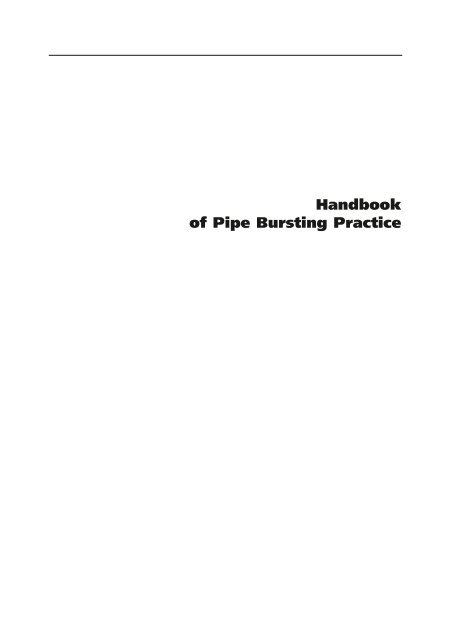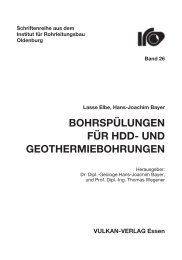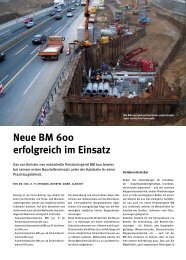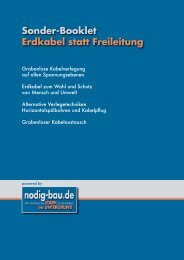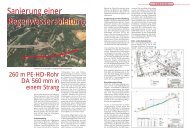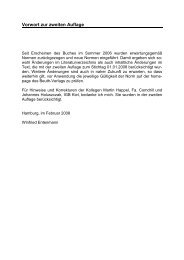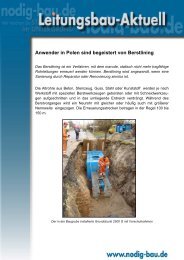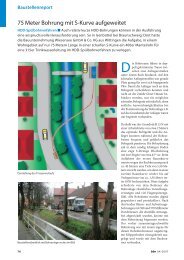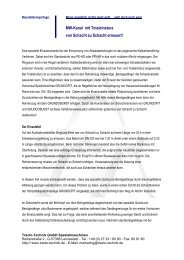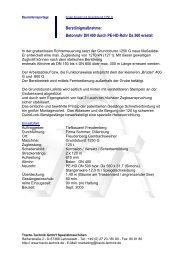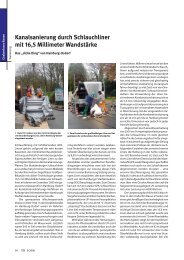Handbook of Pipe Bursting Practice - Nodig-Bau.de
Handbook of Pipe Bursting Practice - Nodig-Bau.de
Handbook of Pipe Bursting Practice - Nodig-Bau.de
Create successful ePaper yourself
Turn your PDF publications into a flip-book with our unique Google optimized e-Paper software.
<strong>Handbook</strong><strong>of</strong> <strong>Pipe</strong> <strong>Bursting</strong> <strong>Practice</strong>
M. Rameil (Editor)3<strong>Handbook</strong><strong>of</strong> <strong>Pipe</strong> <strong>Bursting</strong> <strong>Practice</strong>VULKANVERLAG
Contents 11ContentsForeword .............................................................................................. 5Foreword .............................................................................................. 7Preface ................................................................................................ 8Acknowledgements ............................................................................ 91. Introduction ...................................................................................... 191.1 Definition <strong>of</strong> “pipe bursting” ................................................................ 191.2 History <strong>of</strong> pipe bursting technology .................................................... 191.3 <strong>Pipe</strong> bursting methods ........................................................................ 261.3.1 Dynamic / pneumatic pipe cracking .................................................... 261.3.2 Static pipe bursting .............................................................................. 271.3.3 Calibre pipe bursting ............................................................................ 281.3.4 Method variants .................................................................................... 292. Application range and methodology <strong>of</strong> pipe bursting .......... 312.1 <strong>Bursting</strong> pressure pipes ........................................................................ 312.1.1 Static bursting <strong>of</strong> pressure pipes (mains) ............................................ 312.1.2 Static bursting <strong>of</strong> pressure pipes (service pipes) ................................ 332.1.3 Static replacement <strong>of</strong> pressure pipes (service pipes) – Grundopullsplitting / extracting method ................................................................ 332.1.4 Dynamic / pneumatic pipe cracking <strong>of</strong> pressure pipes (mains) .......... 352.1.5 Dynamic / pneumatic pipe cracking <strong>of</strong> pressure pipes(service pipes) ...................................................................................... 362.1.6 Dynamic / pneumatic extraction <strong>of</strong> steel pipes (potable waterservice pipes) applying piercing tools / impact moles ........................ 372.2 <strong>Bursting</strong> <strong>of</strong> non-pressurised (sewer) pipes .......................................... 382.2.1 Static bursting <strong>of</strong> sewer mains ............................................................ 382.2.1.1 Operating from manhole to manhole .................................................... 382.2.1.2 Operating from manhole to pit ............................................................ 392.2.1.3 Operating from pit to manhole ............................................................ 402.2.1.4 Operating from pit to pit ...................................................................... 412.2.2 Static bursting <strong>of</strong> sewer laterals .......................................................... 422.2.3 Dynamic / pneumatic pipe cracking <strong>of</strong> sewer mains .......................... 432.2.3.1 Operating from manhole to manhole .................................................... 432.2.3.2 Operating from manhole to pit ............................................................ 442.2.3.3 Operating from pit to manhole ............................................................ 442.2.3.4 Operating from pit to pit ...................................................................... 462.2.4 Dynamic / pneumatic pipe cracking <strong>of</strong> sewer laterals ........................ 462.2.5 Calibre pipe bursting ............................................................................ 472.2.6 <strong>Bursting</strong> drainage pipes on waste disposal sites ................................ 472.2.6.1 General remarks .................................................................................. 472.2.6.2 Pits / manholes .................................................................................... 49
12 Contents2.2.6.3 <strong>Pipe</strong> bursting process / suitable pipes ................................................ 493. Performing pipe bursting .............................................................. 513.1 Planning phase .................................................................................... 513.1.1 Host pipe .............................................................................................. 513.1.1.1 Pressure pipes ...................................................................................... 513.1.1.2 Sewage pipes ...................................................................................... 523.1.2 New pipe .............................................................................................. 523.1.3 Survey <strong>of</strong> the un<strong>de</strong>rground conditions in the area <strong>of</strong> the host pipe .... 533.1.4 Bidding process and award <strong>of</strong> contract .............................................. 553.2 Preparation phase ................................................................................ 563.2.1 Selecting the pipe bursting equipment ................................................ 563.2.2 Determination <strong>of</strong> the distance to the surface and to existing pipesand structures ...................................................................................... 573.2.3 Determination <strong>of</strong> individual replacement lengths and launch and exitpit positions .......................................................................................... 583.2.4 Equipment set-up on site .................................................................... 613.2.5 Working pits .......................................................................................... 623.2.6 Taking the host pipe out <strong>of</strong> service ...................................................... 623.2.6.1 Pressure pipes ...................................................................................... 623.2.6.2 Sewage pipes ...................................................................................... 633.2.7 Preparing the pipe bursting equipment ................................................ 633.2.7.1 <strong>Pipe</strong> bursting equipment ...................................................................... 633.2.7.2 Dimensioning <strong>of</strong> the overload protection ............................................ 633.2.8 Incoming control <strong>of</strong> the new pipe material .......................................... 643.2.9 Obstacles and cleaning ........................................................................ 643.3 Performance phase (pipe bursting process and pipe installation) ...... 643.4 Completing phase ................................................................................ 703.4.1 Tests / Inspection .................................................................................. 703.4.1.1 Pressure pipes ...................................................................................... 703.4.1.2 Sewage pipes ...................................................................................... 703.4.2 Net integration ...................................................................................... 703.4.2.1 Pressure pipes ...................................................................................... 703.4.2.2 Sewage pipes ...................................................................................... 703.4.3 Restoring the ground surface .............................................................. 703.5 Quantity measuring, final account, liability .......................................... 714. Host pipe materials suitable for pipe bursting ...................... 734.1 Gas and water supply pipes ................................................................ 734.1.1 Cast iron pipes (CIP) ............................................................................ 734.1.2 Ductile iron pipes (DIP) ........................................................................ 754.1.3 Steel pipes ............................................................................................ 754.1.4 Polyethylene pipes (PE pipes) .............................................................. 764.1.5 PVC pipes (PVC, UPVC pipes) ............................................................ 774.1.6 Concrete/Reinforced concrete pipes (CP / RCP) ................................ 774.1.7 Asbestos cement pipes (ACP) .............................................................. 774.1.8 Lead pipes ............................................................................................ 78
<strong>Pipe</strong> <strong>Bursting</strong> - the Breakthrough in <strong>Pipe</strong> RenewalIt’s wise to choose the pipe bursting replacement method in cases <strong>of</strong>damaged pipes. With the Grundoburst system (5 mo<strong>de</strong>ls) old pipescan be replaced with new pipes <strong>of</strong> smaller, equal or larger diameter- up to ND 1000. Why Grundoburst? Because even ductile and greycast iron, steel, plastic and many other pipes can be replacedwith PVC/HD-PE coiled or short pipes. The patented QuickLock ®bursting rods are not screwed but simply clicked together giving hugetime savings plus increased productivity <strong>of</strong> up to 200 m and more per day.Grundoburst is also suitable for applying the Tight-In-<strong>Pipe</strong> (TIP) method.All in all MORE than you expect.Grundoburst 400 S Grundoburst 400 G Grundoburst 800 G Grundoburst 1250 G Grundoburst 2500 GTHE ONLY CHOICE FOR PERFECT PIPE INSTALLATIONSGermany:Tracto-Technik GmbH & Co. KGTel: +49 2723 80 80Fax: +49 2723 80 81 80www.tracto-technik.<strong>de</strong>export@tracto-technik.<strong>de</strong>United Kingdom:TT UK Ltd.Tel.: +44 1234.342.566Fax: +44 1234.352.184www.tt-uk.cominfo@tt-uk.comUSA / Canada:TT TechnologiesTel.: +1 630.851.8200Fax: +1 630.851.8299www.tttechnologies.cominfo@tttechnologies.comAustralia:TT Asia Pacific Pty Ltd.Tel.: +61 7 3420 5455Fax: +61 7 3420 5855www.tt-asiapacific.cominfo@tt-asiapacific.comFrance:Tracto-Techniques S.a.r.l.Tél.: +33 5.53.53.89.83Fax: +33 5.53.09.39.41www.tracto-techniques.comttf@tracto-techniques.fr
14 Contents4.1.9 Already repaired pressure pipes .......................................................... 794.2 Sewage pipes ...................................................................................... 794.2.1 Vitrified clay pipes (VCP) ...................................................................... 794.2.2 Concrete/Reinforced concrete pipes (CP / RCP) ................................ 804.2.3 Plastic pipes (PE-pipes, PVC-pipes, PP-pipes, GRP) .......................... 814.2.4 Asbestos cement pipes (ACP) .............................................................. 824.2.5 Cast iron pipes / steel pipes ................................................................ 824.2.6 Brick pipe (BP) ...................................................................................... 824.2.7 Already renovated pipes ...................................................................... 825. Suitable new pipe materials ........................................................ 875.1 Pressure pipes ...................................................................................... 885.1.1 Plastic pipes ........................................................................................ 885.1.1.1 Polyethylene pipes (PE) ........................................................................ 885.1.1.2 Cross-linked polyethylene pipes (PE-Xa) ............................................ 935.1.2 Ductile iron pipes (DIP) ........................................................................ 955.1.3 Steel pipes ............................................................................................ 975.2 Non-pressure pipes .............................................................................. 985.2.1 Plastic pipes ........................................................................................ 985.2.1.1 Polyethylene pipes (PE) ........................................................................ 985.2.1.2 Polypropylene pipes (PP) ...................................................................... 1005.2.1.3 Glass-fibre reinforced plastic pipes (GRP) .......................................... 1025.2.1.4 Polyvinylchlori<strong>de</strong> pipes (PVC-pipes) .................................................... 1025.2.2 Ductile iron pipes / Steel pipes ............................................................ 1045.2.3 Vitrified clay pipes (VCP) ...................................................................... 1045.2.4 Concrete / Polymere concrete pipes (CP / PCP) ................................ 1056. Economic efficiency consi<strong>de</strong>rations: Comparisonbetween pipe bursting and open trench installations .......... 1076.1 Introduction .......................................................................................... 1076.2 An example - Comparative consi<strong>de</strong>rations .......................................... 1106.2.1 Equipment utilisation and number <strong>of</strong> transports .................................. 1116.2.2 Required construction time .................................................................. 1116.2.3 Occupied traffic areas .......................................................................... 1126.2.4 Factor noise and dust .......................................................................... 1126.2.5 Required quantity <strong>of</strong> bulk material ...................................................... 1126.2.6 Indirect costs ........................................................................................ 1136.2.6.1 Surface follow-up costs ........................................................................ 1146.2.6.2 Costs caused by traffic disruption ...................................................... 1146.2.6.3 Costs caused by damaged trees and un<strong>de</strong>rgrowth ............................ 1146.2.6.4 Costs caused by negative influence on businesses and commerce .. 1146.2.6.5 Follow-up costs caused by health impairment .................................... 1146.3 Conclusion ............................................................................................ 1157. <strong>Pipe</strong> bursting equipment .............................................................. 1177.1 Introduction .......................................................................................... 117
Contents 157.2 Static pipe bursting .............................................................................. 1177.2.1 <strong>Bursting</strong> rig (push/pulling <strong>de</strong>vice) ........................................................ 1177.2.1.1 <strong>Bursting</strong> rig for threa<strong>de</strong>d rods or bursting rig for QuickLock rods? .... 1197.2.1.2 Pit launched bursting rig ...................................................................... 1217.2.1.3 Manhole launched bursting rig ............................................................ 1237.2.2 <strong>Bursting</strong> rods ........................................................................................ 1237.2.2.1 Threa<strong>de</strong>d or QuickLock rods? .............................................................. 1237.2.2.2 Rod feeding magazine .......................................................................... 1267.2.2.3 Special rods .......................................................................................... 1267.2.3 Hydraulic power units .......................................................................... 1277.2.4 <strong>Bursting</strong> tools ........................................................................................ 1287.2.5 Expan<strong>de</strong>rs ............................................................................................ 1307.2.6 Pulling heads ........................................................................................ 1327.2.7 Recovery Tools .................................................................................... 1337.2.8 Short pipe tensioning <strong>de</strong>vices .............................................................. 1337.2.9 Tensile force data loggers .................................................................... 1347.2.10 Cleaning Accessories .......................................................................... 1357.3 Dynamic / pneumatic pipe cracking .................................................... 1367.3.1 <strong>Pipe</strong> cracking hammer .......................................................................... 1367.3.2 Twin capstan winch .............................................................................. 1387.3.3 Compressors ........................................................................................ 1397.3.4 <strong>Pipe</strong> cracking tools .............................................................................. 1397.3.5 Expan<strong>de</strong>rs ............................................................................................ 1407.3.6 Short pipe tensioning <strong>de</strong>vices .............................................................. 1417.3.7 Air hoses, lubricators, shock valve ...................................................... 1428. Method variations .......................................................................... 1438.1 “Tight-In-<strong>Pipe</strong>” (TIP) renovation method .............................................. 1438.1.1 General .................................................................................................. 1438.1.1.1 Long and short pipe-lining with annulus to be filled ............................ 1438.1.1.2 Close-fit-lining with pre-fabricated pipes without necessity <strong>of</strong> fillingthe annulus .......................................................................................... 1458.1.2 Definition <strong>of</strong> Tight-In-<strong>Pipe</strong> method ...................................................... 1468.1.3 Field <strong>of</strong> application .............................................................................. 1478.1.4 “Launch – Exit – Applications” ............................................................ 1488.1.4.1 Operating from manhole to manhole .................................................... 1488.1.4.2 Operating from pit to manhole ............................................................ 1488.1.4.3 Operating from pit to pit ...................................................................... 1498.1.5 Equipment ............................................................................................ 1498.1.6 <strong>Pipe</strong> materials ...................................................................................... 1508.1.7 Conclusion ............................................................................................ 1518.2 Swagelining .......................................................................................... 1539. International pipe bursting job stories ...................................... 1559.1 Replacement <strong>of</strong> a cast iron gas main with new PE pipes inDortmund-Nette, Germany .................................................................. 1579.2 Replacement <strong>of</strong> a cast iron gas main with new PE pipes in a
16 Contentspe<strong>de</strong>strian zone in Dortmund-Hombruch, Germany ............................ 1599.3 Replacement <strong>of</strong> cast iron gas mains with PE pipes in California,USA ...................................................................................................... 1619.4 <strong>Bursting</strong> around the bend: static pipe bursting in New Town,North Dakota, USA .............................................................................. 1639.5 <strong>Pipe</strong> bursting plays key role in water services upgra<strong>de</strong> in Sydney,Australia ................................................................................................ 1679.6 <strong>Pipe</strong> bursting saves historical cultural heritage in Swe<strong>de</strong>n .................. 1699.7 Replacement <strong>of</strong> a cast iron potable water main with new PE pipes inBangor, Northern Ireland ...................................................................... 1719.8 Replacement <strong>of</strong> a cast iron potable water pipe with new PE pipes inBour<strong>de</strong>illes, France .............................................................................. 1749.9 Replacement <strong>of</strong> a cast iron potable water pipe with ductile iron pipesin Gla<strong>de</strong>nbach-Erdhausen, Germany .................................................. 1779.10 Replacement <strong>of</strong> a cast iron spring water pipe with ductile iron pipesin Staufen, Germany ............................................................................ 1819.11 First application <strong>of</strong> a 2500 kN (250 ton) <strong>Bursting</strong> Rig in Germanyreplacing a cast iron potable water pipe with a new steel pipe .......... 1869.12 Replacement <strong>of</strong> a ductile iron potable water – connection lineND 400 (8”) between two Waterworks with new ductile iron pipes inSaarlouis, Germany using <strong>Pipe</strong> <strong>Bursting</strong> and Horizontal directionaldrilling .................................................................................................. 1909.13 NIBCO solutions takes on ductile iron splitting in Illinois, USA .......... 1949.14 Combined replacement <strong>of</strong> a steel gas main and a ductile iron potablewater main with cross-linked Polyethylene pipes PE-Xa in Weilburg,Germany .............................................................................................. 1959.15 Splitting steel water main in California: ARB leads the way ................ 1979.16 Replacement <strong>of</strong> a steel potable water host pipe with new ductile ironpipes in Flensburg, Germany ................................................................ 2009.17 Static <strong>Pipe</strong> <strong>Bursting</strong> at McGuire Air Force Base: Spiniello CompaniesAims High ............................................................................................ 2029.18 Vis-Com, Inc. Sets Static <strong>Pipe</strong> <strong>Bursting</strong> Record in Taos,New Mexico .......................................................................................... 2059.19 Replacement <strong>of</strong> a PE spring water pipe with new PE pipes inUnteregeri (Switzerland) ........................................................................ 2089.20 <strong>Pipe</strong> cracking in the Swiss rocky mountain area ................................ 2109.21 Mastering <strong>Pipe</strong> <strong>Bursting</strong> at Augusta .................................................... 2139.22 Dynamic / pneumatic steel pipe splitting in Siegen-Geisweid,Germany .............................................................................................. 2179.23 <strong>Pipe</strong> cracking at the Point Reyes National Seashore, California,USA ...................................................................................................... 218
18 Contents9.49 Educating the educated in Cork, Ireland .............................................. 2779.50 Lateral pipe bursting makes the gra<strong>de</strong> in Spokane, WA, USA ............ 2809.51 Replacement <strong>of</strong> a 125 mm (5“) VCP sewer lateral pipe with 180 mm(7“) PE short pipe in Osnabrück, Germany .......................................... 2829.52 Replacement <strong>of</strong> a 150 mm (6“) VCP sewer lateral pipe with 160 mm(6“) PVC short pipe in Bornheim, Germany .......................................... 2839.53 Renovation <strong>of</strong> a 250 mm (10“) VCP sewer pipe with special OD242 mm (9.52”) PP-HM short pipes in Olpe, Germany applying theTight-In-<strong>Pipe</strong> (TIP) Method .................................................................. 2859.54 Renovation <strong>of</strong> a 300 mm (12“) VCP sewer pipe with special OD292 mm (11.5”) PP-HM short pipes in Borgholzhausen, Germanyapplying the Tight-In-<strong>Pipe</strong> (TIP) Method .............................................. 2869.55 Renovation <strong>of</strong> a 300 mm (12“) VCP sewer pipe with special OD292 mm (11.5”) PP-HM short pipes in Dortmund, Germany applyingthe Tight-In-<strong>Pipe</strong> (TIP) Method ............................................................ 2899.56 Replacement <strong>of</strong> a 300 mm (12“) concrete sewer pipe with 280 mm(11”) PP-HM short pipes in Siegburg, Germany applying bothcalibre pipe bursting and HDD ............................................................ 2919.57 Replacement <strong>of</strong> a 400 mm (16“) concrete waste dump sewer pipewith 500 mm (20”) PE pipes in Winterberg, Germany applying bothdynamic / pneumatic pipe cracking and HDD .................................... 2939.58 High speed trains continue uninterrupted during un<strong>de</strong>r rail crossingusing trenchless technology ................................................................ 2969.59 Crossing the Tampines Expressway in Singapore .............................. 29910. Quality Assurance, Quality Control, Testing andInspection .......................................................................................... 30310.1 Background .......................................................................................... 30310.2 Failure prevention ................................................................................ 30310.3 Purpose ................................................................................................ 30410.4 Application assessment ........................................................................ 30410.5 Contractor qualifications ...................................................................... 30510.6 Performance specifications .................................................................. 30610.7 Findings ................................................................................................ 30610.8 Conclusions .......................................................................................... 307Annex 1: Mo<strong>de</strong>l bidding texts .................................................................... 308Annex 2: Literature ........................................................................................ 334
1. Introduction 191. Introduction1.1 Definition <strong>of</strong> “pipe bursting”<strong>Pipe</strong> bursting is a eco-friendly trenchless method which replaces existing host pipesby displacing their fragments into the surrounding soil while simultaneously pulling innew protection or utility pipe <strong>of</strong> the same or larger diameter into the void created. Theinstallation <strong>of</strong> new, industrially produced and tested pipes <strong>of</strong> same or larger size is typicalfor this technology whereby all types <strong>of</strong> pressure or non-pressure pipes as well asprotection pipes can be replaced and installed. New long and short pipe sections areequally suitable. <strong>Pipe</strong> bursting can be applied from pit to pit, pit to manhole and manholeto manhole.Caliber pipe bursting <strong>of</strong> sewage pipes is the installation <strong>of</strong> new pipes into the hostpipe with the new pipes <strong>of</strong> slightly smaller outsi<strong>de</strong> diameter compared to the internaldiameter <strong>of</strong> the existing host pipe. Force is only transmitted into the host pipe at damagedpipe sections where the internal diameter is smaller than the expan<strong>de</strong>r’s outsi<strong>de</strong>diameter, e.g. pipe <strong>de</strong>formations or protruding cracks.The expression “Berstlining” or “Burst lining” is common mainly in Germany, and israrely used in other countries. Therefore, this technology is known in English-speakingareas as “<strong>Pipe</strong> <strong>Bursting</strong>”, “<strong>Pipe</strong> Cracking” and “<strong>Pipe</strong> Splitting”. The expression “<strong>Pipe</strong><strong>Bursting</strong>” is the general term for this technology, but also refers to the replacement <strong>of</strong>brittle material host pipes like cast iron, clay or concrete using the static method withrods. The dynamic / pneumatic replacement <strong>of</strong> brittle material host pipes is called“<strong>Pipe</strong> Cracking”. The term “<strong>Pipe</strong> Splitting” refers to ductile material host pipes likesteel, plastic or ductile iron. The terms used in English are more exact, because theydo not refer to a “Lining-Process” but to the actual replacement process <strong>of</strong> “bursting”.1.2 History <strong>of</strong> pipe bursting technology<strong>Pipe</strong> <strong>Bursting</strong> has a long tradition, but would never have been so successful or evenimaginable without piercing tool / impact moling technology and horizontal steel piperamming. The first i<strong>de</strong>a to replace pipes by bursting was elaborated by British Gas andUK´s DJ Ryan engineering company, who on a large scale already applied soil displacementhammers (impact moles) and horizontal ramming machines for trenchlessinstallations <strong>of</strong> pipes and cables in the early 1980s. Also some contractors with selfFig. 1.1: Layout <strong>of</strong> a mo<strong>de</strong>rn pipe bursting process
20 1. IntroductionFig. 1.2:Ryan pipe burstingsystem in the early 1980sma<strong>de</strong> equipment had been using the process as far back as 1975. The term pipe burstingwas not used at this time however contractors were performing this process insome locations, including within the USA and Germany.Since 1981, British Gas and DJ Ryan applied for the first basic method and equipmentpatents in the UK. More patents followed in Europe, USA, Japan and South America.The reason for further <strong>de</strong>velopments in the UK was the so-called “King Report”,according to which there was an urgent need for action in replacing thousands <strong>of</strong> miles<strong>of</strong> <strong>de</strong>fective cast iron gas pipes installed many years earlier. These replacement programmeswere put into practice in the early 1980s and have been carried out eversince.During the first years, the wi<strong>de</strong>r application <strong>of</strong> pipe bursting outsi<strong>de</strong> the UK firstly progressedquite slowly. This was caused by the fact that this technology was patentedby British Gas and DJ Ryan, and British Gas who required technical transfer licencefees from manufacturers and royalties for each installed metre which used this technology.Only a few manufacturers with an eye to the future were willing to commit andto sign licence agreements, which, un<strong>de</strong>r these circumstances, sometimes causedsignificant additional operating costs.As pipe bursting process began to <strong>de</strong>velop in the USA, the market that took hold wasthe replacement <strong>of</strong> sanitary sewer piping. The long term neglect <strong>of</strong> sewer system assetsin the US prompted the US EPA to require some major US cities to embark on longterm sewer replacement/rehabilitation projects. The City <strong>of</strong> Houston, Texas is a primeexample <strong>of</strong> this scenario.Fig. 1.3: “PIM method“ (pneumatic / hydraulic)
1. Introduction 21Fig. 1.4: Brochier pipe cracking method with Grundocrack at the end <strong>of</strong> the 1980s in GermanyThe first German companies to apply pipe bursting technologysince about 1983 were DIGA in Essen and Brochier inNuremberg. Tracto-Technik (TT Group) took on pilot functionamong machine manufacturers. Australia (1985) and theScandinavian countries Finland (1989), Swe<strong>de</strong>n (1986), Norway(1988) and Denmark (1987) were among the countries inwhich the benefits <strong>of</strong> pipe bursting were clearly seen fromthe very beginning. Russia followed around 1990 withIreland, France, Argentina, Chile and Brazil following afterwardsin approximately 1995.With the British Gas patents having expired (Europe 2001,USA 2005) and the method having reached a high technologicallevel, pipe bursting has really boomed world-wi<strong>de</strong>.Spain (2000), South Africa (2003) and China (2003) as well asrecently Singapore, Malaysia, Indonesia and India and othercountries are now replacing their pipe networks by mainlyapplying pipe bursting. Even in Cuba, this method has beenused since 2001.Pneumatically and hydraulically driven pipe bursting systemswere already known from the very beginning <strong>of</strong> the technology<strong>de</strong>velopment. Pneumatic machines had been originallyknown as “PIM machines” (PIM = <strong>Pipe</strong> Insertion Method).[1.1] <strong>de</strong>scribe the PIM method as follows:“The PIM machine is characterized by the following components:– construction as cone for the creation <strong>of</strong> channels withdiameter <strong>of</strong> a protection pipe to be installed,– compressed air driven,– head cone with moveable bla<strong>de</strong>s to be activated externallyvia hydraulic system to burst obstacles like pipefittings and repair collars– rear part with direct towing attachment for the protectionpipe as an integral part <strong>of</strong> the machine.A further characteristic component <strong>of</strong> this technology is awinch to gui<strong>de</strong> the PIM machine and to assist the burstingprocess.”At that time, individual pipeline sections to be replaced withthe PIM machine were already up to 100 m (330 ft) in length,whereas, <strong>de</strong>pen<strong>de</strong>nt on soil conditions, a bursting processup to 0.5 m/min (1.6 ft/min) could be achieved. It was alreadypossible to replace cast iron pipes up to ND 150 mm (6”).The <strong>de</strong>velopment <strong>of</strong> a purely pneumatic Grundocrack burstinghammer consi<strong>de</strong>rably improved the efficiency <strong>of</strong> the PIMmachines. This technology became known as “<strong>Pipe</strong> Cracking.”
22 1. IntroductionFig. 1.5:Grundocrack burstingbla<strong>de</strong> <strong>de</strong>stroying a pipejointGrundocrack pipe bursting hammers are based on the principle <strong>of</strong> horizontal rammingmachines. These hammers had a slotted head upon which a bursting bla<strong>de</strong> wasattached. This tool configuration was successfully used for replacement <strong>of</strong> cast ironpipes. The winch assists the bursting hammer by pulling it, with constant tension,against the host pipe. This enabled a direct force transmission <strong>of</strong> the percussive pistoninto the host pipe and therefore led to greater efficiency, even when bursting jointsand pipe repair clamps. Since then, it was also possible to replace pipelines up to150 m (490 ft) and up to ND 300 (12”) with bursting times <strong>of</strong> 1–2 m/min (3–6 ft/min).Grundocrack pipe cracking hammers are successfully used world-wi<strong>de</strong> to this veryday.The first hydraulic pipe bursting machines were equipped with hydraulically expandableand contractible heads in or<strong>de</strong>r to displace the host pipe into the surrounding soil.They were already called “static pipe bursting machines” at that time. Currently, thisterm has to be reviewed: These machines actually were “static pipe bursting machineswithout bursting rods”. Since they relied on pipe material, they could only be appliedFig. 1.6:“KM <strong>Bursting</strong> Robot“
1. Introduction 23Fig. 1.7:OEMmie Award for QuickLock quick connectionbursting rodsin sewage pipes. Among others, these machines were known as “Clearline Expandit”,“KM <strong>Pipe</strong> <strong>Bursting</strong>” or “exPress <strong>Pipe</strong> <strong>Bursting</strong>”. In the USA, Xpandit was used in Claypipe, Cast Iron and Concrete by the Miller <strong>Pipe</strong>line Corp. This pipe expansion methoddid not gain much acceptance in practice. Due to its operation in sequences, it couldnot keep up with the efficiency <strong>of</strong> the dynamic / pneumatic pipe cracking method orthe mo<strong>de</strong>rn static pipe bursting method with quick connect bursting rods. Also, <strong>de</strong>brisfrom the broken host pipe and trench bedding <strong>of</strong>ten fell behind the interlocking segments<strong>of</strong> the bursting head caused jamming <strong>of</strong> the bursting tool in the full open positionand consequently operational failures.While the first applications in the UK were limited to cast iron gas pipes, applicationrange (also in other countries) exten<strong>de</strong>d very quickly to water and sewage pipes. Alreadythen, polyethylene pipes had been used as replacement host pipes. However,they were <strong>of</strong>ten installed into PVC-protection pipes. For the replacement <strong>of</strong> supplypipes in shallow <strong>de</strong>pths, the bursting systems could be launched and retrieved fromsmall pits. The winch was positioned at the exit pit. The PE-pipes were wel<strong>de</strong>d to apipe string and pulled into the protection pipes after the bursting had been completed.Sewer lines at greater <strong>de</strong>pths are being increasingly replaced by pipe bursting as soonas the new equipment technology allowed much smaller and less costly pits, or evenma<strong>de</strong> pits obsolete. With increasing requirements, the pipe bursting technology ma<strong>de</strong>enormous progress. For example, in or<strong>de</strong>r to save manholes in sewage networks, atechnology combining pneumatics and hydraulics was <strong>de</strong>veloped which, adapted tothese conditions and thus allowed short pipes to be gradually installed into the damagedpipeline.
24 1. IntroductionFig. 1.8: Grundoburst 2500GIn the 1990s the pipe bursting technology range was enriched by a mo<strong>de</strong>rn variation,the static pipe bursting method with bursting rods. In the beginning, the technologywas applied with standard round screw threa<strong>de</strong>d bursting rods, e.g. Clearline Maxi -burst or TT UK´s Grundoburst TX. Shortly thereafter, TT Group <strong>de</strong>veloped a lad<strong>de</strong>rshaped bursting rod with a quick connection which could be connected by a simpleclick instead <strong>of</strong> being screwed together. These so-called “QuickLock” bursting rods <strong>of</strong>fermany technical and economic advantages which will be explained in <strong>de</strong>tail in thefollowing chapters.During the static pipe bursting process with QuickLock rods, a hydraulically drivenbursting rig firstly pushes the rods through the existing host pipe. After arriving in theexit pit, bursting tool, expan<strong>de</strong>r and new pipe are connected to the QuickLock rods.The bursting process and pipe installation is started by pulling back the rods. Rigs <strong>de</strong>velopinga pulling force up to 2500 kN (275 US tons) are available. In 2004, Grundoburst2500G (pulling force <strong>of</strong> 2500 kN / 275 US tons for installing pipes up to1200 mm / 47”) received the Top 100 Award in the USA. This is an annual award forinnovative products in the range <strong>of</strong> construction machines and accessories. It especiallyhonours products from manufacturers who heavily invest in research and <strong>de</strong>velopment.Nowadays, pipe bursting is mainly applied from ND 50 (2”) to ND 800 (31”) for gas andwater pipes as well as from ND 50 (2”) to ND 1000 (39”) for sewage pipes.The number <strong>of</strong> pipelines to be repaired is ever increasing worldwi<strong>de</strong> – e.g. in Germany,important pipeline rehabilitation projects are not carried out due to the <strong>de</strong>vastatingfinancial situation <strong>of</strong> the municipalities.As much <strong>of</strong> the US un<strong>de</strong>rground infrastructure has reached the end <strong>of</strong> its <strong>de</strong>sign life,many cities are aware that they have a major problem lurking un<strong>de</strong>r their streets. Some<strong>of</strong> these cities have been compelled to take action. Many others are not doing muchuntil there is no other alternative. Raising revenue for these massive projects can actuallybe done fairly easily, by small water rate increases. Unfortunately however, thesewater rate increases become political fod<strong>de</strong>r for local <strong>of</strong>ficials who do not want to beseen as the one who raised everybody’s water bill. On the other hand there are somecities that realize their single largest investment is the piping owned by the city. Keep-
1. Introduction 25ing these pipelines mo<strong>de</strong>rn and sized properly is a good investment for the future <strong>of</strong> aforward thinking community.Although these problems cannot be resolved completely, economical technologies cancontribute toward repairing at least the worst damages.<strong>Pipe</strong> bursting is such a technology. According to estimates from Advantica, the pipebursting method has become the most wi<strong>de</strong>ly applied trenchless pipe replacementmethod with more than 50,000 km (31,000 Miles) worldwi<strong>de</strong>.In general, it has to be <strong>de</strong>ci<strong>de</strong>d whether repair, renovation or pipe renewal (replacement)is required. A pipe replacement is necessary:– when repair or renovation is technically or economically inappropriate– when the hydraulic capacity needs to be improved by an increased pipe diameter– when repair or renovation <strong>of</strong>fers only a short term solution with a pipe replacementbeing inevitable– when there is request for a long lasting pipe durability and or a higher product lifespan– when the static loading capacity <strong>of</strong> the <strong>de</strong>fective pipe would be otherwise negativelyaffected<strong>Pipe</strong> replacement by open trenching involves traffic impairment, noise- and emissionpollution when breaking open the surface. Also there is a risk <strong>of</strong> surrounding un<strong>de</strong>rgroundpipe damage, soil and groundwater intervention and higher storage, transportand soil removal costs. These drawbacks can be almost completely avoi<strong>de</strong>d byreplacing pipes using trenchless technology.With the pipe bursting method, the <strong>de</strong>fective or un<strong>de</strong>r dimensioned pipe is crackedwith a burst head and then displaced into the surrounding soil. This creates space forthe new pipe directly proceeding, <strong>of</strong> same or greater diameter. The pipe bursting techniqueallows the replacement <strong>of</strong> <strong>de</strong>fective pipelines in the same path without any substantialinfluences on soil and groundwater. Open trenching which requires the breakingup and repairing <strong>of</strong> valuable surfaces is thereby almost entirely eliminated. In addition,this eco-friendly technique helps to cut down costs consi<strong>de</strong>rably. However, likeany technology, pipe bursting also has its limitations:– at this time, the application range is limited to circular existing pipes,– if necessary, the host pipe has to be taken out <strong>of</strong> service during the bursting process(not necessary e.g. for mains, drainage pipe replacement, etc.),– the course <strong>of</strong> the host pipe must be usable for the new pipeline (e.g. inclination).Heavily encrusted pipes must be cleaned so that bursting rods can be pushedthrough (static bursting) or respectively the winch rope can be pulled in when(dynamic / pneumatic) pipe cracking,– the soil surrounding the host pipe must be displaceable,– house connections have to be installed using pits. This, however, guarantees a pr<strong>of</strong>essionaland safe integration,– sharp bends, flanged joints <strong>of</strong> steel and ductile iron pipes, etc., <strong>de</strong>pending onselection <strong>of</strong> bursting tools require intermediate pits,– pipe slumps (sags) cannot be removed, however, may be reduced,
26 1. Introduction– a minimum distance has to be kept away from existing parallel or crossing pipes aswell as an a<strong>de</strong>quate cover <strong>de</strong>pth.However, the application <strong>of</strong> pipe bursting also <strong>of</strong>fers all advantages <strong>of</strong> a mo<strong>de</strong>rn,trenchless installation method:– pipe bursting is the installation <strong>of</strong> new, industrially produced pipes, which may becompromised when installed by open cut methods,– pipe bursting gives a consi<strong>de</strong>rable reduction in excavation and road works (almostno traffic disturbance, no annoyance <strong>of</strong> the public or noise and dust pollution,reduced construction time and the reduction <strong>of</strong> indirect costs),– high daily output up to 150 m (490 ft) gives a cost-effective replacement and consi<strong>de</strong>rablecost-savings compared to open cut,– almost any pipe material available for trenchless installation methods can beinstalled by pipe bursting, e.g. plastic, ductile iron (DIP), steel, fibre glass reinforcedplastic (GRP) and even vitrified clay (VCP) and polymer-concrete pipes (PCP). However,new plastic and ductile iron pipes are most commonly installed with pipebursting,– pipe bursting allows the replacement <strong>of</strong> almost any host pipe material (some withlimitations),– pipe bursting can be applied for any kind <strong>of</strong> pipe damage as long as the burstingrods can be pushed in (static bursting) or the winch rope can be pulled in (dynamic/ pneumatic pipe cracking),– no reduction <strong>of</strong> pipe diameter, up-size <strong>of</strong> pipe diameter is possible,– preparation <strong>of</strong> the host pipe, like high-pressure cleaning, removal <strong>of</strong> <strong>de</strong>bris andblockages are not necessary (but may possibly be necessary for other reasons),– consi<strong>de</strong>rably less danger <strong>of</strong> uninten<strong>de</strong>d ground settlement compared to open cut,– applicable for pipes in sloped areas and areas with trees, shrubbery and the like,– installing short pipes, bursting is possible from manhole to manhole (manholediameter min. 1000 mm / 39”),– pipe bursting can also be used for the replacement <strong>of</strong> laterals,– pipe bursting is controlled and <strong>de</strong>scribed by worldwi<strong>de</strong> standards, norms andregulations.1.3 <strong>Pipe</strong> bursting methodsMo<strong>de</strong>rn pipe bursting systems are mainly distinguished by the kind <strong>of</strong> force transmission.Besi<strong>de</strong> that, methods are also distinguished by their type <strong>of</strong> propulsion.1.3.1 Dynamic / pneumatic pipe crackingDynamic cracking (also referred to as pneumatic pipe cracking) is assisted by aportable hydraulic winch. A dynamic / pneumatic cracking hammer based on a piercingtool / impact mole or horizontal ramming hammer is used to break and displace thehost pipe. The bursting tools are arranged at the front or rear end (<strong>de</strong>pending on job)<strong>of</strong> the bursting hammer and transmit the ramming energy into the host pipe and crackit. The following expan<strong>de</strong>r displaces the burst fragments <strong>of</strong> the host pipeinto the surrounding soil and enlarges the void so that a new pipe <strong>of</strong> the same orlarger diameter can be pulled in, simultaneously.
1. Introduction 27Fig. 1.9:Dynamic / pneumaticpipe crackingThe procedure starts, however, with pulling the winch rope into the host pipe using aflexible glass fibre rod. The new pipes are joined outsi<strong>de</strong> the pit (e.g. butt-fused polyethylenepipe string). After the new pipe is attached to the cracking hammer and thehammer itself is connected to the air compressor, it is pulled against the host pipe bythe winch.The bursting process commences by starting the compressor. The pulling force <strong>of</strong> thewinch assists the forward movement and directional stability <strong>of</strong> the cracking hammer.When the cracking hammer arrives in the exit pit, it can either be removed there orpulled back through the new pipe into the launch pit in case <strong>of</strong> lack <strong>of</strong> exit pit space.Dynamic / pneumatic pipe cracking machines are available in various size classes and<strong>de</strong>signs for different applications, in the extreme case even host pipes up to ND 1000(39”). The dynamic / pneumatic impact ramming energy for the replacement <strong>of</strong> a waterpipe ND 100 (4”), for example, causes less soil displacement or vibration than a vibratorycompaction plate.1.3.2 Static pipe burstingSpecial QuickLock, lad<strong>de</strong>r-shape bursting rods support the bursting, displacing andpipe pulling procedure <strong>of</strong> the static or also called hydraulic pipe bursting.At first, a hydraulically driven bursting rig is positioned insi<strong>de</strong> the exit pit. A flexiblegui<strong>de</strong> rod ensures smooth installation <strong>of</strong> the bursting rods through the host pipe. Thebursting rods are quickly connected by clicking them together. QuickLock burstingrods are easily and securely linked together, not screwed together like traditional drillrods or other conventional static systems. The QuickLock system speeds the installationprocess as well as the connection procedure. The rods can be quickly ad<strong>de</strong>d oneat a time at the exit pit as the rods are pushed up the old host pipe. Once at the launchpit, the gui<strong>de</strong> rod is replaced by a bursting tool (e.g. bla<strong>de</strong>d bursting head, roller bla<strong>de</strong>cutters), expan<strong>de</strong>r and new pipe.The entire configuration is then pulled back by the hydraulic bursting rig through thehost pipe towards the exit pit. While pulling back the bursting rods into the direction <strong>of</strong>
28 1. IntroductionFig. 1.10:Static <strong>Pipe</strong> <strong>Bursting</strong>the exit pit, the bursting tool fragments the host pipe. The expan<strong>de</strong>r following thebursting tool displaces the fragmented host pipe radially into the surrounding soil sothat a new pipe <strong>of</strong> the same or larger diameter can be pulled in, simultaneously.To save manholes or in case there is lack <strong>of</strong> space on the surface when burstingsewage pipes, it is possible to use special mini-bursting rigs that even fit into manholes<strong>of</strong> 1000 mm (39”) diameter or larger. If, in addition, short-pipes are used, launch an<strong>de</strong>xit pits are completely unnecessary. Laterals, however, have to be re-connected withminimal digging methods e.g. Suction Excavation.1.3.3 Calibre pipe burstingCaliber pipe bursting is an alternative to cured-in-place or lining methods when the hydrauliccapacity <strong>of</strong> the host pipe allows this small reduction in the replacement pipe diameter.<strong>Bursting</strong> <strong>of</strong> the host pipe only occurs (dynamically or statically) where individual,localised damages exist. This method is applied, for example, when damages likelocal <strong>de</strong>formations, cracks or partial collapses occur, whereas the remaining part <strong>of</strong> thepipeline shows no or only minimal damages. Moreover, the host pipe should have sufficienthydraulic capacity, that a reduction <strong>of</strong> diameter by installing a new, slightlysmaller pipe can be accepted from the hydraulic point <strong>of</strong> view.
1. Introduction 29Progress <strong>of</strong> work is much better, becausethe cracking hammer / burstingtool is only activated at the actualdamaged pipe areas, while the newpipe is installed into the remainingsection like in a lining process.Restrictions <strong>of</strong> calibre pipe bursting:– application range limited to circularpipes larger than ND 150 / 6”(short-pipe larger than ND 200 / 8”),– using short-pipes requires a relativelystraight and level host pipelength,– using long pipes requires an installationand machine pit for settingup and removing the bursting rig aswell as for the installation <strong>of</strong> theFig. 1.11: PE-pipe installed with caliberburstingnew pipe (size <strong>de</strong>pen<strong>de</strong>nt on bending radius <strong>of</strong> new pipe),– <strong>Pipe</strong> slumps (sags) cannot be removed but may be reduced,– in case partial or total collapse pushing-in <strong>of</strong> bursting rods respectively pulling-in <strong>of</strong>winch cable is critical.Caliber pipe bursting also <strong>of</strong>fers many advantages:– total restoration <strong>of</strong> structural load capacity,– minimal reduction <strong>of</strong> diameter in case appropriate pipe materials with special sizesare chosen,– applicable for damages like <strong>de</strong>formations, cracks, fractures, breakages, partial collapses,total collapses, slab-outs, etc.,– new pipe with improved hydraulic capacity and reshaping the circular pipe pr<strong>of</strong>ile incase <strong>of</strong> <strong>de</strong>formations and collapses,– when operating from manhole to manhole respectively pit to manhole reduction <strong>of</strong>excavation works is kept to a minimum,– trenchless installation <strong>of</strong> house connections possible,– short set-up times reduce construction and labour costs.1.3.4 Method variantsIn addition to the two classic methods dynamic / pneumatic and static pipe burstingas well as caliber pipe bursting, further variations have been <strong>de</strong>veloped over the years.Some <strong>of</strong> these will be introduced in chapter 8.References[1.1] Hoeper, G, Jonas, K.: Rohrnetzsanierung in Essen, Germany 3R International Edition January/ February 1986


